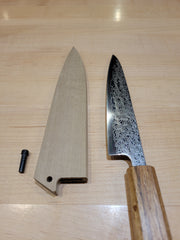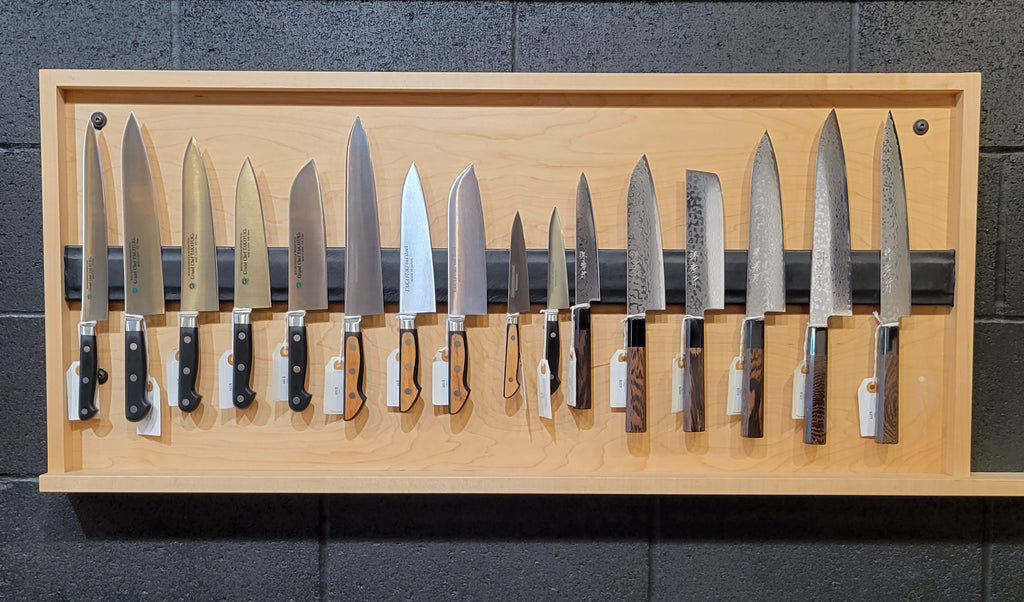Where do I begin?
Welcome to the first of our periodic Seisuke Knife informational blog posts! My name is Jun, and here we’ll be discussing a wide range of knife-related topics. This week, we’ll be going over the ins and outs of selecting your first Japanese kitchen knife.
Considering the numerous different qualities that go into each knife out there, choosing your first one can feel quite daunting. Luckily, we’re here to help make that process much easier. Let’s begin!
Step 1: Identify your tasks
Plain and simple, all knives have a single purpose: to cut things. However, if you can narrow down exactly what types of things you’d like to cut, you’ll be able to find a knife style more suited for that particular job. Not only will using the right tool for the right job make you more efficient, but it will also make food prep a lot safer, as you will be performing actions as designed by your blade (remember, safety first!)
For example, if you’re looking for a good vegetable cutter, a nakiri or usuba would be a great choice. Maybe you only need a knife for small, delicate work like peeling and garnish prep; try a petty knife. If you’d like to make some beautiful meat cuts, a sujihiki might be right up your alley. Or perhaps you just want a solid, reliable knife that can perform any general task; look no further than a gyuto or santoku chef’s knife. The Seisuke Knife website offers a neat, filterable catalog of each style along with their applications!

In descending order: nakiri, gyuto, and petty.
Step 2: Identify your steel type
Now that you’ve narrowed down the type of knife that you’re looking for, the next step is selecting which of two steel types is better for your purposes, and how it might affect your knife experience.
There are generally two categories of steel types that Japanese kitchen knives are forged with: stainless steel and high-carbon steel. They both have their pros and cons, but whichever you choose is also dependent on a mix of personal preference and the type of work you’ll be doing with your knife. Let’s take a look at their differences!
STAINLESS STEEL
You’ve probably seen this stuff everywhere; stainless steel cookware, surgical tools, parts of buildings, etc. Of course, it’s good for knives too. Stainless steel contains elemental properties that give it resistance to staining and rusting. While the carbon content can vary depending on the specific stainless steel, in general they are softer than high-carbon steel, making them easier to maintain. However, their softness also means they will lose their edge more quickly, thus requiring more frequent sharpening. Due to their trusty durability and easier maintenance, stainless steels make for good entry-level knives, and are great for those who just want a simple but robust knife experience for general kitchen use.
HIGH-CARBON STEEL
High-carbon steels, as their name suggests, contain more carbon in their molecular makeup. They are built to last, holding a sharp, formidable edge for longer stretches of time, assuming they are cared for and stored properly. Because they lack chromium and other elements present in stainless steels, they are prone to rusting. Their high levels of hardness, owing to their high-carbon content, also makes them more brittle and susceptible to chipping. With the right care and proper use, high-carbon steel knives serve their users incredibly well, and are especially liked by industry professionals and those who seek the utmost precision in their cutting work.

A high-carbon steel knife (left) and stainless steel knife (right). Stainless steel knives contain chromium, which gives them their corrosion-resistant properties and a generally shinier look!
That’s a lot to take in, so let’s look at these steels side-by-side and review their pros and cons:
|
STAINLESS STEEL |
HIGH-CARBON STEEL |
|
PROS Easier to maintain Rust resistant More durable overall CONS Limited sharpness Shorter edge retention More frequent sharpening necessary |
PROS Sharper edge Longer edge retention Less frequent sharpening needed CONS Higher maintenance Prone to rusting Brittle, can chip |
What this ultimately comes down to is personal preference! For a low-maintenance, more forgiving, and more beginner-friendly knife experience, stainless steel is an excellent choice. For someone who feels comfortable with a more intensive level of knife care and maintenance, high-carbon steel can be very rewarding. Either way, with the right usage and care, both steel types can perform phenomenally.
Step 3: Identify your handle
Now that you’ve determined your knife style and steel type, the next step is figuring out which handle you like the most. In Japanese kitchen knives, there are generally two handle types: Western-style and Japanese-style (also known as yo- and wa-handles, respectively). The two types are pictured below this section!
Western-style handles have a curvy, asymmetrical profile and metal rivets. They also tend to be weightier due to their full tang, meaning the part of the blade that resides within the handle runs all the way through it. While handle choice simply comes down to personal preference, Western-style handles are widely praised for their ergonomics, as their curvature is made to fit peoples’ hands more naturally.
Japanese-style handles are symmetrical and more cylindrical than Western-style handles, with some sporting a distinct ferrule just before the blade. These handles are typically half tang; that is, the blademetal within the handle only runs about halfway through. This makes for a lighter knife overall, with weight situated more towards the blade tip.
As I’ve said earlier, whichever handle you pick depends entirely on your own personal preference, style, sense of comfort, and so forth. Many love the hefty, strong feeling of a Western-style handle while others prefer the lighter, more graceful experience offered by a Japanese-style handle. Both handles come in a variety of wood types like oak, elm, magnolia, mahogany, and many more.

Western-style handle (left) and a Japanese-style handle (right). Octagonal/oval shapes are common with the latter.
Step 4: Think about storage
After finalizing your decision, you should also consider what sort of storage would be best for your new knife in order to extend its longevity and prevent damage or accidents. If you purchase from Seisuke, the box that comes with your knife will serve as an adequate short-term storage device. A sheath, also known as a saya, is even better if you want something durable and less cumbersome than a box. A saya also comes with a pin to prevent the knife from falling out. A knife rack, knife block, or even a magnetic rack are also great options for kitchen settings. Whichever way you go about it, the main idea is to keep the knife away from places where it may clatter against other objects. A hidden knife might hurt someone rummaging through a cabinet, too! For high-carbon steel knives, storing it in a moisture-free area is also important to prevent oxidation.


Knives fit snugly into a saya with a holding pin.

Knife racks can make for easier knife access and also make for neat displays!
That's it!
I have hopefully, by the end of this entry, made the knife-selection process more approachable and easy! Let's quickly review each step:
1. Select a knife style suited to the type of work you'll be doing.
2. Determine which steel type is more suitable to your preferences.
3. Figure out which handle-style you like the most.
4. Consider a storage device to protect your knife.
By following these steps, you'll ensure that you are picking the right knife for you!
-Jun


Comments (0)